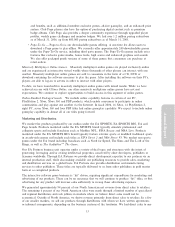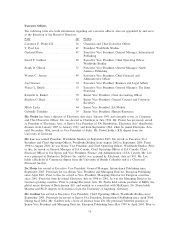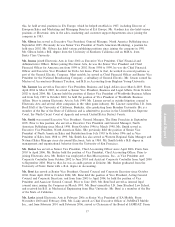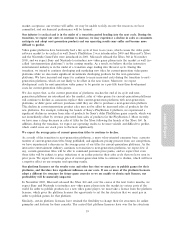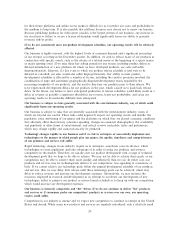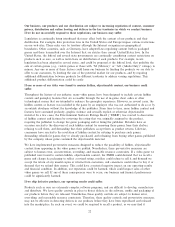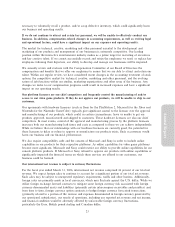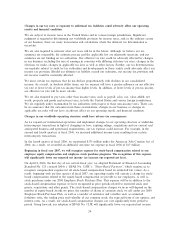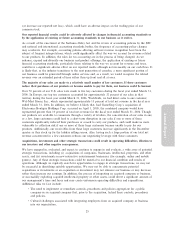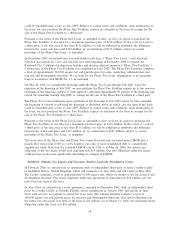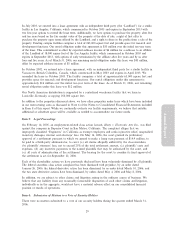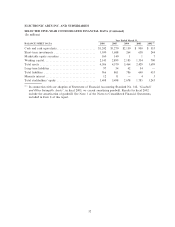Electronic Arts 2006 Annual Report Download - page 94
Download and view the complete annual report
Please find page 94 of the 2006 Electronic Arts annual report below. You can navigate through the pages in the report by either clicking on the pages listed below, or by using the keyword search tool below to find specific information within the annual report.Our business, our products and our distribution are subject to increasing regulation of content, consumer
privacy, distribution and online hosting and delivery in the key territories in which we conduct business.
If we do not successfully respond to these regulations, our business may suÅer.
Legislation is continually being introduced that may aÅect both the content of our products and their
distribution. For example, data protection laws in the United States and Europe impose various restrictions
on our web sites. Those rules vary by territory although the Internet recognizes no geographical
boundaries. Other countries, such as Germany, have adopted laws regulating content both in packaged
games and those transmitted over the Internet that are stricter than current United States laws. In the
United States, the federal and several state governments are continually considering content restrictions on
products such as ours, as well as restrictions on distribution of such products. For example, recent
legislation has been adopted in several states, and could be proposed at the federal level, that prohibits the
sale of certain games (e.g., violent games or those with ""M (Mature)'' or ""AO (Adults Only)'' ratings) to
minors. Any one or more of these factors could harm our business by limiting the products we are able to
oÅer to our customers, by limiting the size of the potential market for our products, and by requiring
additional diÅerentiation between products for diÅerent territories to address varying regulations. This
additional product diÅerentiation could be costly.
If one or more of our titles were found to contain hidden, objectionable content, our business could
suÅer.
Throughout the history of our industry, many video games have been designed to include certain hidden
content and gameplay features that are accessible through the use of in-game cheat codes or other
technological means that are intended to enhance the gameplay experience. However, in several cases, the
hidden content or feature was included in the game by an employee who was not authorized to do so or by
an outside developer without the knowledge of the publisher. From time to time, some hidden content and
features have contained profanity, graphic violence and sexually explicit or otherwise objectionable
material. In a few cases, the Entertainment Software Ratings Board (""ESRB'') has reacted to discoveries
of hidden content and features by reviewing the rating that was originally assigned to the product,
requiring the publisher to change the game packaging and/or Ñning the publisher. Retailers have on
occasion reacted to the discovery of such hidden content by removing these games from their shelves,
refusing to sell them, and demanding that their publishers accept them as product returns. Likewise,
consumers have reacted to the revelation of hidden content by refusing to purchase such games,
demanding refunds for games they've already purchased, and refraining from buying other games published
by the company whose game contained the objectionable material.
We have implemented preventative measures designed to reduce the possibility of hidden, objectionable
content from appearing in the video games we publish. Nonetheless, these preventative measures are
subject to human error, circumvention, overriding, and reasonable resource constraints. If a video game we
published were found to contain hidden, objectionable content, the ESRB could demand that we recall a
game and change its packaging to reÖect a revised rating, retailers could refuse to sell it and demand we
accept the return of any unsold copies or returns from customers, and consumers could refuse to buy it or
demand that we refund their money. This could have a material negative impact on our operating results
and Ñnancial condition. In addition, our reputation could be harmed, which could impact sales of other
video games we sell. If any of these consequences were to occur, our business and Ñnancial performance
could be signiÑcantly harmed.
If we ship defective products, our operating results could suÅer.
Products such as ours are extremely complex software programs, and are diÇcult to develop, manufacture
and distribute. We have quality controls in place to detect defects in the software, media and packaging of
our products before they are released. Nonetheless, these quality controls are subject to human error,
overriding, and reasonable resource constraints. Therefore, these quality controls and preventative measures
may not be eÅective in detecting defects in our products before they have been reproduced and released
into the marketplace. In such an event, we could be required to recall a product, or we may Ñnd it
22



